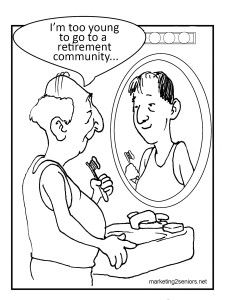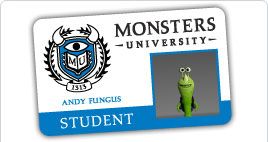
by Diane Masson | Nov 29, 2015

“I am not ready yet.” Illustration courtesy of, “Your Senior Housing Options” book.
Every single one of us knows a senior who is struggling in their home. Some seniors silently suffer and others have a whole network of support from family and friends.
- Daughters may call their mom once a day to inquire if her senior parent is okay OR no answer could mean they fell again and need help.
Result: Senior falls often lead to fractured hips, 911 calls, skilled nursing care with physically therapy and needing 24/7 care.
- A son may set his senior parent up with medications in a pillbox and then call two or three times a day to make sure his parent has taken them.
Result: This can be effective until the senior says, “What are these pills for? I don’t want to take them.” Most family members are not there in person twice a day to make sure the senior ingests the pills.
- Kind neighbors may make an extra plate of dinner every night and take it to their senior neighbor.
Result: Neighbors get frustrated and burned out, spending every single night away from their own family for one year or more. This type of support can’t go on and on.
- Daughters may spend every other Saturday cleaning mom’s house, grocery shopping and setting up her senior parent to survive for another two weeks.
Result: Even if the daughter lives two hours away, this type of help eventually turns into every Saturday. If the daughter works full time, it can never be daily help, then what?
What is the answer to a senior struggling to manage in their home?
Result: It’s time to talk turkey with a senior.
There are five typical results in having “The Talk” with a senior:
- Denial: “I am just fine living in my own home. I am not ready yet.”
- Shutting down: “I don’t want to discuss this.”
- Anger: “Why are you questioning my ability to be independent? Leave me alone.”
- Confusion: “Don’t you want to come see me everyday? I don’t understand.”
- Acceptance: “I understand that I have become a burden. Maybe it’s time to look at what my senior housing options could be. I am tired of being lonely. Will you help me look?”
In my 17-year senior housing career, my teams and I have helped thousands of seniors improve the quality of their life by making a planned move into an independent living, assisted living or Continuing Care Retirement Community. No one ever chooses memory care or skilled nursing, but those are options for many seniors (like my own in-laws) who waited too long and ended up in a health care crisis. Both my in-laws were hospitalized simultaneously in different hospitals and both their doctor’s told them they needed 24/7 care and could not return home. There was so much unnecessary suffering in my family and I don’t wish it on anyone. Such as my mother-in-law with dementia being given psychotropic medications (they don’t mix well). She has never been the same. Maybe my experiences can save you from a senior health care crisis?
Next week my blog will feature: 7 Tips to have “The Talk” with a Senior.
If this article struck a cord with you, please share it on social media to help others. If you have a friend or neighbor going through a struggle with a senior, let them know about next week’s blog.
Give the gift of knowledge: “Your Senior Housing Options” is an easy read with illustrations. It walks seniors and their adult children through the costs and pitfalls of navigating senior housing and includes the chapter on the “7 Deadly Sins of Searching for Senior Housing Options.”
News Flash: Diane Masson’s new interview on Generation Bold Radio will broadcast on Sunday, December 6th on the BizTalkRadio Network syndicated to 33 stations across the country.
Diane Masson is a senior living expert who has authored two 5-star rated books sold through Amazon. Her new book is an all-encompassing answer guide for seniors called, “Your Senior Housing Options,” designed to help seniors navigate choices quickly. The second book was written for senior living professionals called, Senior Housing Marketing – How To Increase Your Occupancy and Stay Full. Reach out to her through her website: Tips2Seniors.com and read the weekly blog.

by Diane Masson | Aug 11, 2013
 Disney’s “Monsters University” movie really struck a cord with me.
Disney’s “Monsters University” movie really struck a cord with me.
The “Monsters University” movie was about a team who perseveres through a “Scary Competition” together. As a newly formed team, they didn’t believe in each other. As the experience grew they started to believe. When Mike (the small green one-eyed monster with the heart of a lion) took the the monsters on a field trip, the entire team saw that each of them could be a scary winner individually and really trusted each other. The scary team became invested in supporting one another and helping weak players grow stronger.
Even the mean lady who was the dean of “Monsters University” was surprised by the perseverance of Mike and Sulley (the big furry blue and purple monster). NO ONE believed in this team of misfits. Yet they proved to go above and beyond what anyone in the school had ever done before. When the dean locked Mike and Sully in the human world, Mike figured out a way to get out with the help of Sulley TRUSTING Mike. Mike was the brain and Sulley was the brawn. Individually they would not have made it, as a team of two who TRUSTED each other, they were successful.
When senior living sales people are new – they don’t know whom to trust on the operations team. Will their co-worker have his or her back or throw them under the bus? It’s important to have a good on-boarding system that creates experiences to build team trust.
Here are several ideas to help develop trust on your senior living team:
- If several of your key staff interview the candidate, they will believe in the newbie’s talents from the initial interview meeting. Their belief needs to be shared with the rest of the long-term leadership.
- Ask each department head to welcome the new employee to your senior living team and share their role and how it interacts with the newbie.
- Depending on the newbie’s position create a plan for them to understand their role within your organization’s mission.
- Create mentoring moments between the new employee and several long-term staff.
- Have a staff person with longevity introduce the new person to residents, possibly at the resident council meeting.
- If you have a click of core leaders, ask them to welcome the newbie at lunch.
- Develop a team experience where the newbie can learn AND share their own talents – maybe it’s an event for the residents, a weekly book review, special project or morning stand up meeting.
What are you doing to build trust between a newbie and your existing senior living team? What on-boarding best practices have worked for you?
Please share your success, failures or comment to join the conversation and interact with other senior living professionals on what is currently being effective to increase occupancy on a nationwide basis.
Diane Twohy Masson is the best-selling author of “Senior Housing Marketing – How to Increase Your Occupancy and Stay Full,” available at Amazon.com with a 5-star rating. The book is required reading at George Mason University as a part of its marketing curriculum. Within this book, the author developed a sales & marketing method with 12 keys to help senior living providers increase their occupancy. Masson developed this expertise as a marketing consultant, sought-after blogger for senior housing and a regional marketing director of continuing care retirement communities in several markets. She has also been a corporate director of sales and a mystery shopper for independent living, assisted living, memory care and skilled care nursing communities in multiple states. Most recently Masson was recruited to consult for two debt-free Continuing Care Retirement Communities in Southern California – Freedom Village in Lake Forest and The Village in Hemet, California. Interestingly, this career started when she was looking for a place for her own mom and helped her loved one transition through three levels of care.

by Diane Masson | Jun 2, 2013
 Are you strategizing out your next move with warm and hot senior housing leads on a daily or weekly basis? A senior living sales person should always take time to reflect after an appointment with a prospective resident. Immediately input notes into your lead database system (like REPS). If you wait until the end of the day or don’t use a database system, this could be negatively affecting your occupancy. Jot down some key situational information:
Are you strategizing out your next move with warm and hot senior housing leads on a daily or weekly basis? A senior living sales person should always take time to reflect after an appointment with a prospective resident. Immediately input notes into your lead database system (like REPS). If you wait until the end of the day or don’t use a database system, this could be negatively affecting your occupancy. Jot down some key situational information:
- Where are they living now? Home value?
- What prompted his or hers visit?
- Is anyone helping them now?
- What is their greatest concern?
- Are they lonely?
- Health issues?
- Pets?
- What is most important to them in a future home?
- Which apartments did you show them and which one did they like best?
- Assets? Monthly income?
- What did they like best about your retirement community?
- Could they see themselves living in your community?
- Timeframe for moving in?
As a senior living sales person reflects on the above situation, a strategy for the next step in the sales process can start to formulate. It is extremely beneficial to run this by a sales collogue, your director of marketing or your executive director. I don’t care how many years that you have worked in this business; two heads can strategize better than one. I discuss hot leads with my teams every week. Team members contribute excellent suggestions to help a warm lead become hot or help turn a hot lead into a move-in.
Strategizing leads can be the spice of life to help increase your occupancy! It works!!!
Please comment to join the conversation and interact with other senior living professionals on what is currently being effective to increase occupancy on a nationwide basis.
Diane Twohy Masson is the author of “Senior Housing Marketing – How to Increase Your Occupancy and Stay Full,” available for sale at Amazon.com. Masson’s book will be required reading at George Mason University in the Fall as part of the marketing curriculum. She is currently consulting with Seniors For Living and two debt-free Continuing Care Retirement Communities in Southern California – Freedom Village in Lake Forest and The Village in Hemet, California. Connection and partnership opportunities: Email: diane@marketing2seniors.net

by Diane Masson | Feb 24, 2013
 What Is The Best Incentive You Have Ever Given In Senior Living?
What Is The Best Incentive You Have Ever Given In Senior Living?
Discounting can be the owner’s operational nightmare and the sales persons best friend. Incentives cost the company money and affect the bottom line. Just giving away one month of rent can cost $2000 – $6000 depending on the retirement community. Yet, empty apartments are losing revenue month-after-month. Should you or should you not use incentives?
I believe that incentives can permanently ruin some sales people. Some sales people can ONLY sell apartments with incentives. When the gravy train stops they don’t know how to just simply sell an apartment at regular price to a senior. Seriously?!? In my opinion, this is right up there with someone who is simply an order taker in senior living.
The benefit of incentives is bumping up the occupancy to get ahead of the move outs in a very short period of time. Every senior living community has to look at their financials and determine what is best for them. If you have more two-bedrooms than one-bedrooms, an incentive on two-bedrooms can create balance again in your inventory. It is a funny thing in our industry – how every five years the surplus of a certain size apartment switches. Right now everyone seems to want a one bedroom…
Here are some common assisted living and independent living incentives:
- One free month
- The fourth month free
- No move in fee or a discount on the community fee
- A free TV
- A moving or downsizing allowance
Continuing Care Retirement Communities can use the same or different incentives:
- 90 – 100% Returnable entrance fees
- A percentage off future healthcare
- Paying for the move completely
- Discounting apartments that are the farthest walk from the dining room
- A discount off the entrance fee if a prospect commits to moving in within a short period of time
Do you use incentives? Which ones? Which incentive in your career resulted in the biggest flurry of sales for your retirement community? My favorite incentive of all time was a 100% returnable entrance fee at a new community that I opened. It worked like a charm! Within months, 70% of the building was spoken for, so we could start construction.
Please comment to join the conversation and interact with other senior living professionals on what is currently being effective to increase occupancy on a nationwide basis.
Diane Twohy Masson is the author of “Senior Housing Marketing – How to Increase Your Occupancy and Stay Full,” available for sale at Amazon.com. Masson’s book will be required reading at George Mason University in the Fall as part of the marketing curriculum. She is currently consulting with Seniors For Living and two debt-free Continuing Care Retirement Communities in Southern California – Freedom Village in Lake Forest and The Village in Hemet, California. Connection and partnership opportunities: Email: diane@marketing2seniors.net

by Diane Masson | Jan 27, 2013

Momentum in Senior Living
Are you losing senior residents faster than gaining new ones at your retirement community? Welcome to 2013, where older and frailer new residents don’t spend much time at your senior living community before moving onto a higher level of care or meeting their maker…
If you have more move-outs than move-ins year after year, your occupancy has slowly dropped. It’s time to get the big “MO” back – that’s right momentum!
Are your owners only looking at the bottom line and demanding for the occupancy numbers to increase? Or, are your owners willing to strategize with sales and marketing to look outside the sales box and figure out how to make the building more attractive to younger seniors? The later is the key…it can be a one-year process of improvements and upgrades. (Hint: Younger seniors live at your retirement community longer!)
The results can be phenomenal! A community I work with in Southern California just had 7 CCRC entrance fee sales in 8 days! Yes, some younger residents, including couples are moving in too. The CCRC community looks fantastic now after extensive renovations! The sale team is excited and all the scheduled move-ins generate urgency for other prospective residents to move-in now, because the apartment home inventory is dwindling.
What are you doing to attract younger seniors and build momentum for occupancy?
Please comment to join the conversation and interact with other senior living professionals on what is currently being effective to increase occupancy on a nationwide basis.
Diane Twohy Masson is the author of “Senior Housing Marketing – How to Increase Your Occupancy and Stay Full,” available for sale at Amazon.com. Masson’s book will be required reading at George Mason University in the Fall as part of the marketing curriculum. She is currently consulting with Seniors For Living and two debt-free Continuing Care Retirement Communities in Southern California – Freedom Village in Lake Forest and The Village in Hemet, California. Connection and partnership opportunities: Email: diane@marketing2seniors.net





